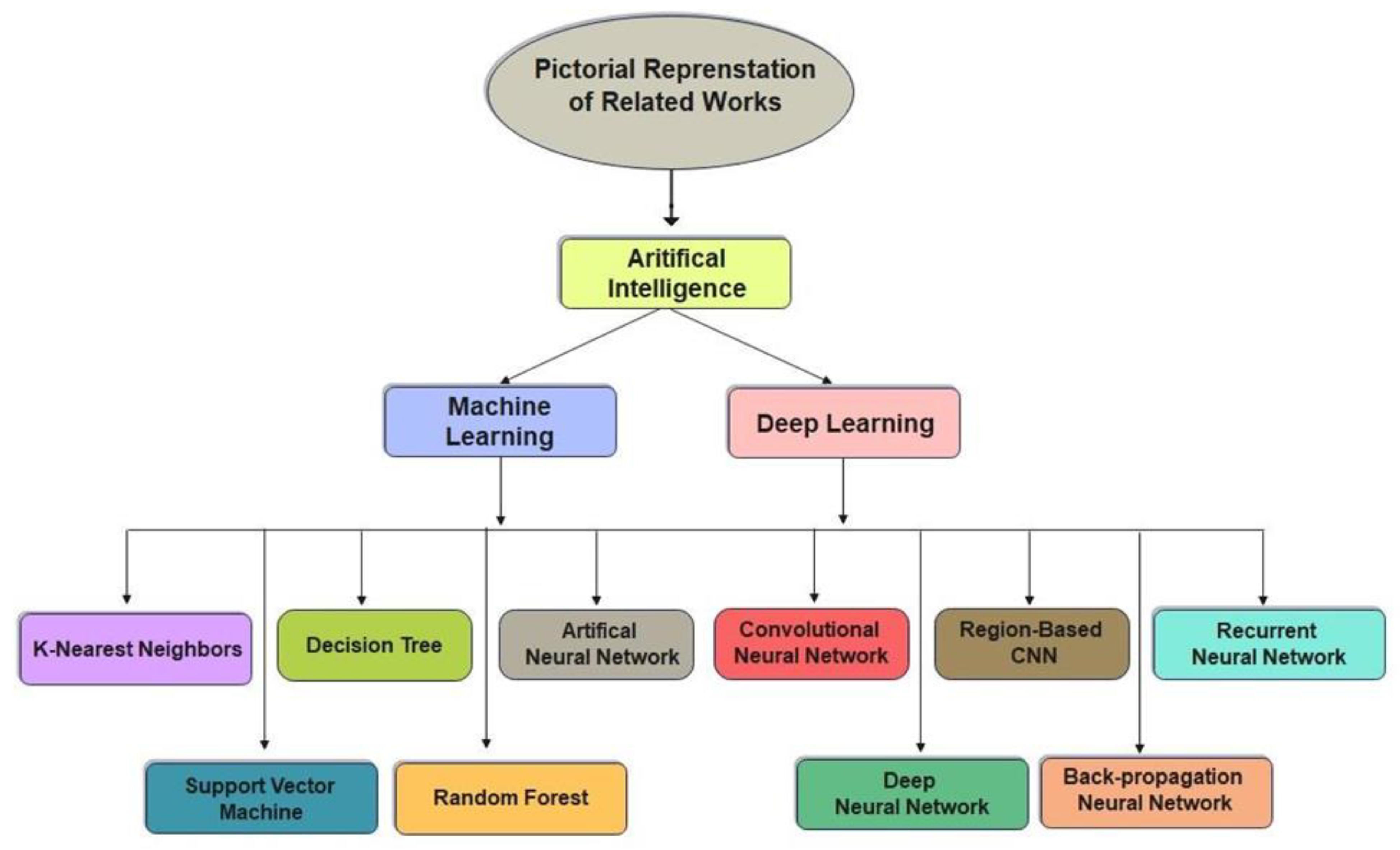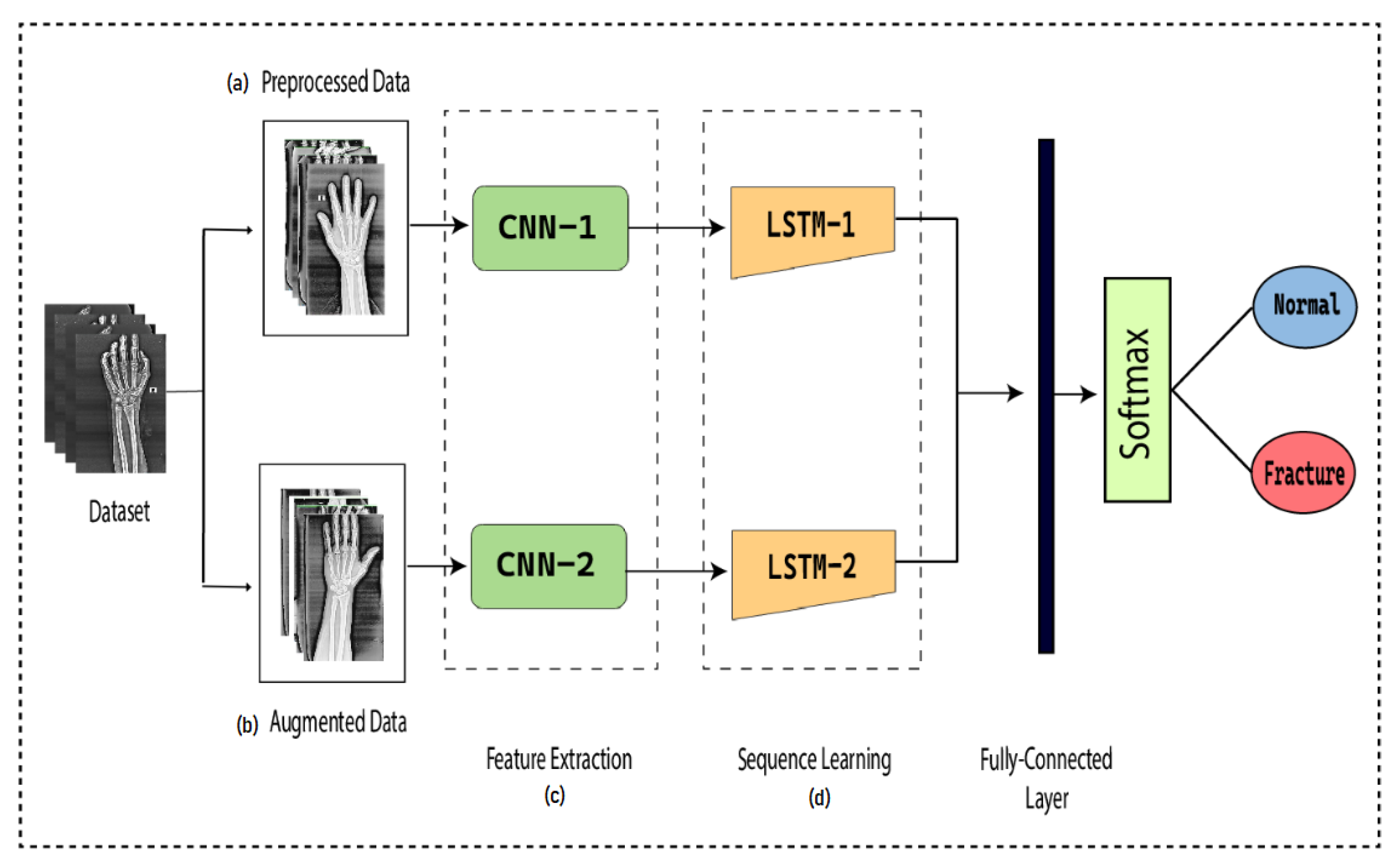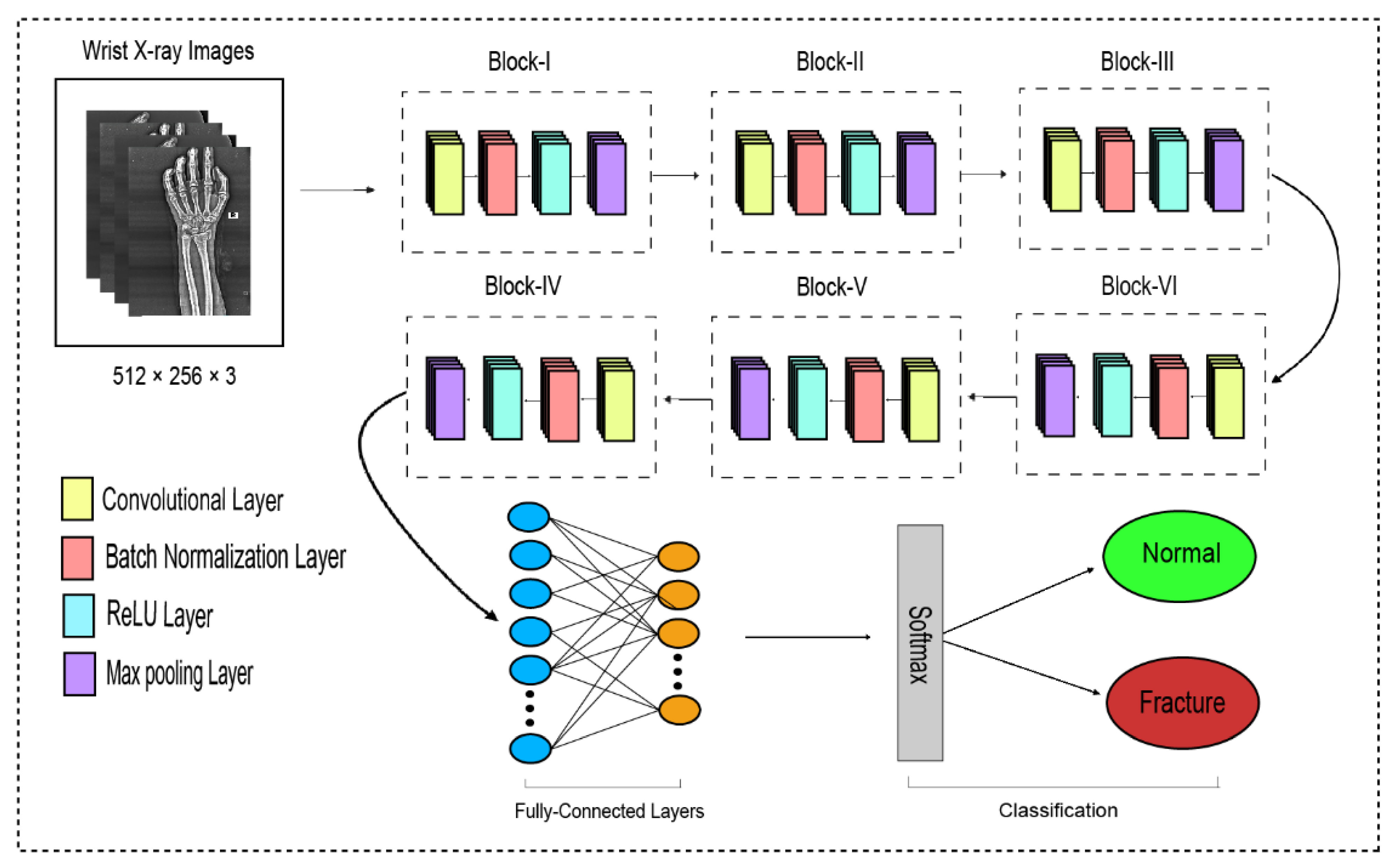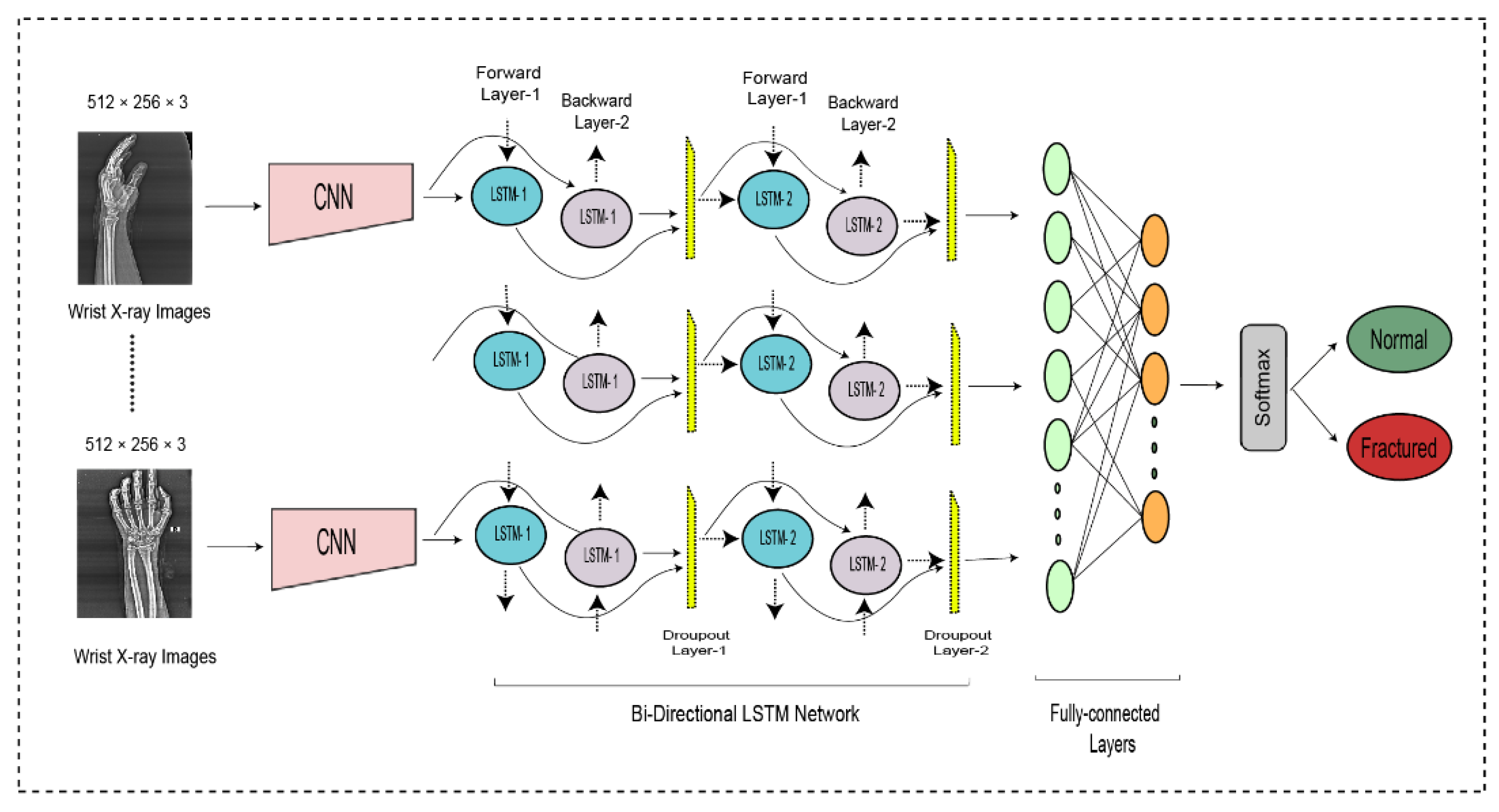A Minority Class Balanced Approach Using the DCNN-LSTM Method to Detect Human Wrist Fracture
Abstract
1. Introduction
- (a)
- To alleviate clinicians’ cognitive load, the two-method model adopted in this research detects significant fracture areas in an X-ray image.
- (b)
- A fusion method, DCNN-LSTM, is proposed that can automatically diagnose wrist fractures to facilitate the radiologist.
- (c)
- The first model, the DCNN, is designed to enhance the CNN’s receptive field by using a dilation factor in the convolution operation, which lessens the complexity of the CNN training phase.
- (d)
- The fused model DCNN-LSTM enhances accuracy with augmented data to recognize anomalies using wrist X-ray images.
- (e)
- The entire research work is structured as follows: Section 2 presents related works on fractures. Section 3 provides an overview of the proposed methodology, comprising dataset acquisition and analysis. Section 4 includes a discussion of the results and an evaluation of the proposed methodology. Section 5 concludes the research work.
2. Related Works
3. Proposed Methodology
3.1. Data Normalization and Pre-Processing
3.2. Data Augmentation
3.3. Proposed Dilated CNN
- Input Layer:
- Convolution Layer:
- Batch Normalization Layer:
- Rectified Linear Unit (ReLU):
- Pooling Layer:
- Fully Connected Layer:
- Softmax Layer:
3.4. Feature Extraction
3.5. LSTM
3.6. Bidirectional LSTM
- Sequence Input Layer
- BiLSTM Layer
- Dropout Layer
- Fully connected layer
- Softmax Layer
4. Results and Discussion
4.1. Dataset Description
4.2. Performance Evaluation
- True-positive (TP) outputs include positive images (fractured) that are accurately classified as fractured.
- True-negative (TN) outputs include normal images that are accurately classified as non-fractured.
- False-positive (FP) outputs include normal images that are inaccurately classified as fractured.
- False-negative (FN) outputs include positive images (fractured) that are inaccurately classified as non-fractured (normal).
4.3. Experiment 1 (Non-Augmented Data)
4.4. Experiment 2 (Augmented Data)
5. Conclusions
Author Contributions
Funding
Institutional Review Board Statement
Informed Consent Statement
Data Availability Statement
Conflicts of Interest
References
- Brink, M.; Steenbakkers, A.; Holla, M.; de Rooy, J.; Cornelisse, S.; Edwards, M.J.; Prokop, M. Single-shot CT after wrist trauma: Impact on detection accuracy and treatment of fractures. Skelet. Radiol. 2019, 48, 949–957. [Google Scholar] [CrossRef] [PubMed]
- Üreten, K.; Sevinç, H.F.; İğdeli, U.; Onay, A.; Maraş, Y. Use of deep learning methods for hand fracture detection from plain hand radiographs. Turk. J. Trauma Emerg. Surg. 2022, 28, 196–201. [Google Scholar] [CrossRef] [PubMed]
- Bagaria, R.; Wadhwani, S.; Wadhwani, A.K. Bone fractures detection using support vector machine and error backpropagation neural network. Optik 2021, 247, 168021. [Google Scholar] [CrossRef]
- Umadevi, N.; Geethalakshmi, S. Multiple classification system for fracture detection in human bone x-ray images. In Proceedings of the 2012 Third International Conference on Computing, Communication and Networking Technologies (ICCCNT’12), Coimbatore, India, 26–28 July 2012. [Google Scholar]
- Cao, Y.; Wang, H.; Moradi, M.; Prasanna, P.; Syeda-Mahmood, T.F. Fracture detection in x-ray images through stacked random forests feature fusion. In Proceedings of the 2015 IEEE 12th International Symposium on Biomedical Imaging (ISBI), Brooklyn, NY, USA, 16–19 April 2015. [Google Scholar]
- Greenspan, H.; Van Ginneken, B.; Summers, R.M. Guest editorial deep learning in medical imaging: Overview and future promise of an exciting new technique. IEEE Trans. Med. Imaging 2016, 35, 1153–1159. [Google Scholar] [CrossRef]
- LeCun, Y.; Bengio, Y.; Hinton, G. Deep learning. Nature 2015, 521, 436–444. [Google Scholar] [CrossRef] [PubMed]
- Esteva, A.; Robicquet, A.; Ramsundar, B.; Kuleshov, V.; DePristo, M.; Chou, K.; Cui, C.; Corrado, G.; Thrun, S.; Dean, J. A guide to deep learning in healthcare. Nat. Med. 2019, 25, 24–29. [Google Scholar] [CrossRef] [PubMed]
- Olczak, J.; Fahlberg, N.; Maki, A.; Razavian, A.S.; Jilert, A.; Stark, A.; Sköldenberg, O.; Gordon, M. Artificial intelligence for analyzing orthopedic trauma radiographs: Deep learning algorithms—Are they on par with humans for diagnosing fractures? Acta Orthop. 2017, 88, 581–586. [Google Scholar] [CrossRef]
- Yahalomi, E.; Chernofsky, M.; Werman, M. Detection of distal radius fractures trained by a small set of X-ray images and Faster R-CNN. In Proceedings of the Intelligent Computing-Proceedings of the Computing Conference, London, UK, 16–17 July 2019. [Google Scholar]
- Xie, H.; Yang, D.; Sun, N.; Chen, Z.; Zhang, Y. Automated pulmonary nodule detection in CT images using deep convolutional neural networks. Pattern Recognit. 2019, 85, 109–119. [Google Scholar] [CrossRef]
- Ragab, D.A.; Sharkas, M.; Marshall, S.; Ren, J. Breast cancer detection using deep convolutional neural networks and support vector machines. PeerJ 2019, 7, e6201. [Google Scholar] [CrossRef]
- Zhang, J.; Li, Z.; Yan, S.; Cao, H.; Liu, J.; Wei, D. An Algorithm for Automatic Rib Fracture Recognition Combined with nnU-Net and DenseNet. Evid.-Based Complement. Altern. Med. 2022, 2022, 5841451. [Google Scholar] [CrossRef]
- Urakawa, T.; Tanaka, Y.; Goto, S.; Matsuzawa, H.; Watanabe, K.; Endo, N. Detecting intertrochanteric hip fractures with orthopedist-level accuracy using a deep convolutional neural network. Skelet. Radiol. 2019, 48, 239–244. [Google Scholar] [CrossRef]
- Joshi, D.; Singh, T.P.; Joshi, A.K. Deep learning-based localization and segmentation of wrist fractures on X-ray radiographs. Neural Comput. Appl. 2022, 34, 19061–19077. [Google Scholar] [CrossRef]
- Kitamura, G.; Chung, C.Y.; Moore, B.E. Ankle fracture detection utilizing a convolutional neural network ensemble implemented with a small sample, de novo training, and multiview incorporation. J. Digit. Imaging 2019, 32, 672–677. [Google Scholar] [CrossRef] [PubMed]
- Doerr, S.A.; Weber-Levine, C.; Hersh, A.M.; Awosika, T.; Judy, B.; Jin, Y.; Raj, D.; Liu, A.; Lubelski, D.; Jones, C.K. Automated prediction of the Thoracolumbar Injury Classification and Severity Score from CT using a novel deep learning algorithm. Neurosurg. Focus 2022, 52, E5. [Google Scholar] [CrossRef] [PubMed]
- El-Saadawy, H.; Tantawi, M.; Shedeed, H.A.; Tolba, M.F. Deep Learning Method for Bone Abnormality Detection Using Multi-View X-rays. In Proceedings of the International Conference on Artificial Intelligence and Computer Vision, Settat, Morocco, 28–30 June 2021. [Google Scholar]
- Chung, S.W.; Han, S.S.; Lee, J.W.; Oh, K.-S.; Kim, N.R.; Yoon, J.P.; Kim, J.Y.; Moon, S.H.; Kwon, J.; Lee, H.-J. Automated detection and classification of the proximal humerus fracture by using deep learning algorithm. Acta Orthop. 2018, 89, 468–473. [Google Scholar] [CrossRef]
- Schudlo, L.C.; Xie, Y.; Small, K.; Graf, B. A novel CNN+ LSTM approach to classify frontal chest x-rays for spine fractures. In Proceedings of the Medical Imaging 2022: Computer-Aided Diagnosis, San Diego, CA, USA, 20 February–28 March 2022. [Google Scholar]
- El-Saadawy, H.; Tantawi, M.; Tolba, M. Bone X-Rays Classification and Abnormality Detection using Xception Network. Int. J. Intell. Comput. Inf. Sci. 2021, 21, 82–95. [Google Scholar] [CrossRef]
- Solovyova, A.; Solovyov, I. X-ray bone abnormalities detection using MURA dataset. arXiv 2020, arXiv:2008.03356. [Google Scholar]
- Myint, W.W.; Tun, K.S.; Tun, H.M. Analysis on leg bone fracture detection and classification using X-ray images. Mach. Learn. Res. 2018, 3, 49–59. [Google Scholar] [CrossRef]
- Yao, L.; Guan, X.; Song, X.; Tan, Y.; Wang, C.; Jin, C.; Chen, M.; Wang, H.; Zhang, M. Rib fracture detection system based on deep learning. Sci. Rep. 2021, 11, 23513. [Google Scholar] [CrossRef]
- Choi, J.W.; Cho, Y.J.; Ha, J.Y.; Lee, Y.Y.; Koh, S.Y.; Seo, J.Y.; Choi, Y.H.; Cheon, J.-E.; Phi, J.H.; Kim, I. Deep learning-assisted diagnosis of pediatric skull fractures on plain radiographs. Korean J. Radiol. 2022, 23, 343. [Google Scholar] [CrossRef]
- Tomita, N.; Cheung, Y.Y.; Hassanpour, S. Deep neural networks for automatic detection of osteoporotic vertebral fractures on CT scans. Comput. Biol. Med. 2018, 98, 8–15. [Google Scholar] [CrossRef] [PubMed]
- Kim, D.; MacKinnon, T. Artificial intelligence in fracture detection: Transfer learning from deep convolutional neural networks. Clin. Radiol. 2018, 73, 439–445. [Google Scholar] [CrossRef] [PubMed]
- Kim, K.C.; Cho, H.C.; Jang, T.J.; Choi, J.M.; Seo, J.K. Automatic detection and segmentation of lumbar vertebrae from X-ray images for compression fracture evaluation. Comput. Methods Programs Biomed. 2021, 200, 105833. [Google Scholar] [CrossRef] [PubMed]
- Guan, B.; Zhang, G.; Yao, J.; Wang, X.; Wang, M. Arm fracture detection in X-rays based on improved deep convolutional neural network. Comput. Electr. Eng. 2020, 81, 106530. [Google Scholar] [CrossRef]
- Thian, Y.L.; Li, Y.; Jagmohan, P.; Sia, D.; Chan, V.E.Y.; Tan, R.T. Convolutional neural networks for automated fracture detection and localization on wrist radiographs. Radiol. Artif. Intell. 2019, 1, e180001. [Google Scholar] [CrossRef] [PubMed]
- Guan, B.; Yao, J.; Zhang, G.; Wang, X. Thigh fracture detection using deep learning method based on new dilated convolutional feature pyramid network. Pattern Recognit. Lett. 2019, 125, 521–526. [Google Scholar] [CrossRef]
- Ebsim, R.; Naqvi, J.; Cootes, T. Fully automatic detection of distal radius fractures from posteroanterior and lateral radiographs. In Computer Assisted and Robotic Endoscopy and Clinical Image-Based Procedures; Springer: Berlin/Heidelberg, Germany, 2017; pp. 91–98. [Google Scholar]
- Li, L.; Song, X.; Guo, Y.; Liu, Y.; Sun, R.; Zou, H.; Zhou, H.; Fan, X. Deep convolutional neural networks for automatic detection of orbital blowout fractures. J. Craniofacial Surg. 2020, 31, 400–403. [Google Scholar] [CrossRef]
- Zeelan Basha, C.; Maruthi Padmaja, T.; Balaji, G. Automatic X-ray image classification system. In Smart Computing and Informatics; Springer: Berlin/Heidelberg, Germany, 2018; pp. 43–52. [Google Scholar]
- Cheng, C.-T.; Ho, T.-Y.; Lee, T.-Y.; Chang, C.-C.; Chou, C.-C.; Chen, C.-C.; Chung, I.; Liao, C.-H. Application of a deep learning algorithm for detection and visualization of hip fractures on plain pelvic radiographs. Eur. Radiol. 2019, 29, 5469–5477. [Google Scholar] [CrossRef]
- Yadav, D.; Rathor, S. Bone fracture detection and classification using deep learning approach. In Proceedings of the 2020 International Conference on Power Electronics & IoT Applications in Renewable Energy and its Control (PARC), Mathura, India, 28–29 February 2020. [Google Scholar]
- Ebsim, R.; Naqvi, J.; Cootes, T.F. Automatic detection of wrist fractures from posteroanterior and lateral radiographs: A deep learning-based approach. In Proceedings of the International Workshop on Computational Methods and Clinical Applications in Musculoskeletal Imaging, Granada, Spain, 16 September 2018. [Google Scholar]
- Oyeranmi, A.; Ronke, B.; Mohammed, R.; Edwin, A. Detection of Fracture Bones in X-ray Images Categorization. Kwara State Univ. Malete Nigeria. Br. J. Math. Comput. Sci. 2020, 35, 1–11. [Google Scholar] [CrossRef]
- San Myint, K.T. Implementation of Lower Leg Bone Fracture Detection from X-ray Images. Int. J. Trend Sci. Res. Dev. 2019, 3, 2411–2415. [Google Scholar]
- Mondol, T.C.; Iqbal, H.; Hashem, M. Deep CNN-based ensemble CADx model for musculoskeletal abnormality detection from radiographs. In Proceedings of the 2019 5th International Conference on Advances in Electrical Engineering (ICAEE), Dhaka, Bangladesh, 26–28 September 2019. [Google Scholar]
- Lindsey, R.; Daluiski, A.; Chopra, S.; Lachapelle, A.; Mozer, M.; Sicular, S.; Hanel, D.; Gardner, M.; Gupta, A.; Hotchkiss, R. Deep neural network improves fracture detection by clinicians. Proc. Natl. Acad. Sci. USA 2018, 115, 11591–11596. [Google Scholar] [CrossRef]
- Chittajallu, S.M.; Mandalaneni, N.L.D.; Parasa, D.; Bano, S. Classification of Binary Fracture Using CNN. In Proceedings of the 2019 Global Conference for Advancement in Technology (GCAT), Bangalore, India, 18–20 October 2019. [Google Scholar]
- Vasilakakis, M.; Iosifidou, V.; Fragkaki, P.; Iakovidis, D. Bone fracture identification in x-ray images using fuzzy wavelet features. In Proceedings of the 2019 IEEE 19th International Conference on Bioinformatics and Bioengineering (BIBE), Athens, Greece, 28–30 October 2019. [Google Scholar]
- Dimililer, K. IBFDS: Intelligent bone fracture detection system. Procedia Comput. Sci. 2017, 120, 260–267. [Google Scholar] [CrossRef]
- Hržić, F.; Tschauner, S.; Sorantin, E.; Štajduhar, I. Fracture Recognition in Paediatric Wrist Radiographs: An Object Detection Approach. Mathematics 2022, 10, 2939. [Google Scholar] [CrossRef]
- Zhang, X.; Zou, Y.; Shi, W. Dilated convolution neural network with LeakyReLU for environmental sound classification. In Proceedings of the 2017 22nd international conference on digital signal processing (DSP), London, UK, 23–25 August 2017. [Google Scholar]
- Raghavendra, U.; Bhat, N.S.; Gudigar, A.; Acharya, U.R. Automated system for the detection of thoracolumbar fractures using a CNN architecture. Future Gener. Comput. Syst. 2018, 85, 184–189. [Google Scholar] [CrossRef]
- Li, X.; Zhai, M.; Sun, J. DDCNNC: Dilated and depthwise separable convolutional neural Network for diagnosis COVID-19 via chest X-ray images. Int. J. Cogn. Comput. Eng. 2021, 2, 71–82. [Google Scholar] [CrossRef]
- Passricha, V.; Aggarwal, R.K. A hybrid of deep CNN and bidirectional LSTM for automatic speech recognition. J. Intell. Syst. 2020, 29, 1261–1274. [Google Scholar] [CrossRef]
- Xu, X.; Jeong, S.; Li, J. Interpretation of electrocardiogram (ECG) rhythm by combined CNN and BiLSTM. IEEE Access 2020, 8, 125380–125388. [Google Scholar] [CrossRef]
- Kavianpour, P.; Kavianpour, M.; Jahani, E.; Ramezani, A. A cnn-bilstm model with attention mechanism for earthquake prediction. arXiv 2021, arXiv:2112.13444. [Google Scholar]




| Fracture Type | Image Type | Feature Extraction Model | Classifier Used | Accuracy | Year |
|---|---|---|---|---|---|
| Leg bone fracture [23] | X-ray | Harris algorithm | Decision tree (DT) and KNN | 82% | 2018 |
| Rib fracture [24] | CT scan | - | 3D DenseNet | 86.9% | 2021 |
| Skull fracture [25] | X-ray | YOLOv3 | 91.7% | 2022 | |
| Osteoporotic vertebral fractures [26] | CT scan | ResNet34 | CNN/LSTM) | 89.2% | 2018 |
| Fracture detection [27] | X-ray | - | CNN | 95.4% | 2018 |
| Wrist fracture [28] | Inception-ResNet version | Faster R-CNN | 62.04% | 2019 | |
| Lumbar vertebra compression fracture [29] | X-ray | Post-driven Learning | DL techniques and level-set methods (Pose-net and M-net) | 91.60% | 2020 |
| Distal radius fractures [30] | Distal Radius Fractures | - | Random forest (RF) | 91.4% | 2017 |
| Arm fracture [31] | X-ray | - | YOLOv4 | 81.91% | 2021 |
| Thigh fracture [32] | X-ray | - | Dilated convolutional feature pyramid network (DCFPN) | 82.1% | 2019 |
| Orbital blowout fractures [33] | CT scan | Inception-V3 convolutional neural network (CNN) | Inception V3 CNN and XGBoost | 92% | 2019 |
| Fracture detection [34] | X-ray | - | BPNN, SVM, and PNN | 92.3% | 2018 |
| Hip fractures [35] | PXR | - Grad-CAM | Deep convolutional neural network (DCNN) | 91% | 2019 |
| Bone dracture [36] | X-ray | - | Deep CNN (Adam optimizer and softmax) | 92.44% | 2020 |
| Wrist dractures [37] | X-ray | - | Convolutional neural network (CNN) | 96% | 2018 |
| Bone fracture [38] | X-ray | Hough transformation | KNN and SVM | 90% | 2020 |
| Arm fracture [39] | X-ray | ResNet | Fast R-CNN | 2020 | |
| Elbow fractures [40] | X-ray | - | CNN Xception (Vision model) | 88% | 2019 |
| Wrist fraction [41] | X-ray | VGG-19 and ResNet | Deep CNN using VGG-19, ResNet | 87.8% | 2019 |
| Fracture detection [42] | X-ray | - | DCNN | 91.5% | 2018 |
| Wrist fracture [43] | X-ray | - | YOLOV4 | 96.5% | 2022 |
| Binary fracture [44] | X-ray | Binary entropy function | Convolutional neural network (CNN) | Hands 80.45% Legs 84.75% Ribs 80.65% Other 86.75% | 2019 |
| Bone fracture [45] | X-ray | 2D DWT | Wavelet fuzzy phrases (WFP) | 84% | 2019 |
| Number | Layer Name | Activations | Kernel Size | Stride | Parameters | Feature Maps |
|---|---|---|---|---|---|---|
| 1 | Input layer | 512 × 256 × 3 | / | / | / | / |
| 2 | Convolutional layer (C1) | 512 × 256 × 16 | 5 × 5 | 1 | Weights = 5 × 5 × 3 × 16 Bias = 1 × 1 × 16 | 16 |
| 3 | Batch normalization (B1) | 512 × 256 × 16 | / | / | Offset = 1 × 1 × 16 Scale = 1 × 1 × 16 | 16 |
| 4 | ReLU (R1) | 512 × 256 × 16 | / | / | / | / |
| 5 | Max-pooling layer (MP1) | 256 × 128 × 16 | 2 × 2 | 2 | / | / |
| 6 | Convolutional layer (C2) | 256 × 128 × 32 | 5 × 5 | 1 Dilation factor = 2 | Weights = 5 × 5 × 16 × 32 Bias = 1 × 1 × 32 | 32 |
| 7 | Batch normalization (B2) | 256 × 128 × 32 | / | / | Offset = 1 × 1 × 32 Scale = 1 × 1 × 32 | 32 |
| 8 | ReLU (R2) | 256 × 128 × 32 | / | / | / | / |
| 9 | Max-pooling layer (MP2) | 128 × 64 × 32 | 2 × 2 | 2 | / | / |
| 10 | Convolutional layer (C3) | 128 × 64 × 64 | 5 × 5 | 1 Dilation factor = 4 | Weights = 5 × 5 × 32 × 64 Bias = 1 × 1 × 64 | 64 |
| 11 | Batch normalization (B3) | 128 × 64 × 64 | / | / | Offset = 1 × 1 × 64 Scale = 1 × 1 × 64 | 64 |
| 12 | ReLU (R3) | 128 × 64 × 64 | / | / | / | / |
| 13 | Max-pooling layer (MP3) | 64 × 32 × 64 | 2× 2 | 2 | / | / |
| 14 | Convolutional layer (C4) | 64 × 32 × 128 | 5 × 5 | 1 Dilation factor = 8 | Weights = 5 × 5 × 64 × 128 Bias = 1 × 1 × 128 | 128 |
| 15 | Batch normalization (B4) | 64 × 32 × 128 | / | / | Offset = 1 × 1 × 128 Scale = 1 × 1 × 128 | 128 |
| 16 | ReLU (R4) | 64 × 32 × 128 | / | / | / | / |
| 17 | Max-pooling layer (MP4) | 32 × 16 × 128 | 2 × 2 | 2 | / | / |
| 18 | Convolutional layer (C5) | 32 × 16 × 128 | 5 × 5 | 1 Dilation factor = 16 | Weights = 5 × 5 × 128 × 128 Bias = 1 × 1 × 128 | 128 |
| 19 | Batch normalization (B5) | 32 × 16 × 128 | / | / | Offset = 1 × 1 × 128 Scale = 1 × 1 × 128 | 128 |
| 20 | ReLU (R5) | 32 × 16 × 128 | / | / | / | / |
| 21 | Max-pooling layer (MP5) | 16 × 8 × 128 | 2 × 2 | 2 | / | / |
| 22 | Convolutional layer (C6) | 16 × 8 × 256 | 5 × 5 | 1 Dilation factor = 32 | Weights = 5 × 5 × 128 × 256 Bias = 1 × 1 × 256 | 256 |
| 23 | Batch normalization (B6) | 16 × 8 × 256 | / | / | Offset = 1 × 1 × 256 Scale = 1 × 1 × 256 | 256 |
| 24 | ReLU (R6) | 16 × 8 × 256 | / | / | / | / |
| 25 | Max-pooling layer (MP6) | 8 × 4 × 256 | 2 × 2 | 2 | / | / |
| 26 | Fully connected layer (FC) | 1 × 1 × 2 | / | / | Weights = 2 × 8192 Bias = 2 × 1 | 2 |
| 27 | Softmax | 1 × 1 × 2 | / | / | / | / |
| 28 | Classification layer | / | / | / | / | / |
| Number | Layer Name | Activations | Parameters |
|---|---|---|---|
| 1 | Sequence input layer | 2 | / |
| 2 | BiLSTM | 2000 | Input weights = 8000 × 1 Recurrent weights = 8000 × 2000 Bias = 8000 × 2 |
| 3 | Dropout layer | 2000 | / |
| 4 | BiLSTM | 1000 | Input weights = 4000 × 2000 Recurrent weights = 4000 × 1000 Bias = 4000 × 1 |
| 5 | Dropout layer | 1000 | / |
| 6 | Fully connected layer | 2 | Input weights = 2 × 1000 Bias = 2 × 1 |
| 7 | Softmax | 2 | / |
| Variables | Actual Data | Pre-Processed Data | Augmented Data |
|---|---|---|---|
| Wrist X-ray images | 192 | 192 | 192 |
| Fractured images | 111 | 111 | 555 |
| Normal images | 82 | 82 | 410 |
| Dimension | Different sizes, such as 344 × 596, 252 × 650, 328 × 624, and 264 × 622 | 512 × 256 | 512 × 256 |
| Format | JPG file | JPG file | JPG file |
| Total images | 192 | 192 | 965 |
| Methods | Accuracy | Precision | Sensitivity | Specificity | F1-Score | Kappa |
|---|---|---|---|---|---|---|
| DCNN 1 | 84.48% | 87.50% | 84.85% | 84% | 86.15% | 68.52% |
| DCNN-LSTM 1 | 86.21% | 87.88% | 87.88% | 84% | 87.88% | 71.88% |
| Methods | Accuracy | Precision | Sensitivity | Specificity | F1-Score | Kappa |
|---|---|---|---|---|---|---|
| DCNN-2 | 86.54% | 86.93% | 92.17% | 81.30% | 89.47% | 74.25% |
| DCNN-LSTM 2 | 88.24% | 87.93% | 92.17% | 82.93% | 90% | 75.7% |
Disclaimer/Publisher’s Note: The statements, opinions and data contained in all publications are solely those of the individual author(s) and contributor(s) and not of MDPI and/or the editor(s). MDPI and/or the editor(s) disclaim responsibility for any injury to people or property resulting from any ideas, methods, instructions or products referred to in the content. |
© 2023 by the authors. Licensee MDPI, Basel, Switzerland. This article is an open access article distributed under the terms and conditions of the Creative Commons Attribution (CC BY) license (https://creativecommons.org/licenses/by/4.0/).
Share and Cite
Rashid, T.; Zia, M.S.; Najam-ur-Rehman; Meraj, T.; Rauf, H.T.; Kadry, S. A Minority Class Balanced Approach Using the DCNN-LSTM Method to Detect Human Wrist Fracture. Life 2023, 13, 133. https://doi.org/10.3390/life13010133
Rashid T, Zia MS, Najam-ur-Rehman, Meraj T, Rauf HT, Kadry S. A Minority Class Balanced Approach Using the DCNN-LSTM Method to Detect Human Wrist Fracture. Life. 2023; 13(1):133. https://doi.org/10.3390/life13010133
Chicago/Turabian StyleRashid, Tooba, Muhammad Sultan Zia, Najam-ur-Rehman, Talha Meraj, Hafiz Tayyab Rauf, and Seifedine Kadry. 2023. "A Minority Class Balanced Approach Using the DCNN-LSTM Method to Detect Human Wrist Fracture" Life 13, no. 1: 133. https://doi.org/10.3390/life13010133
APA StyleRashid, T., Zia, M. S., Najam-ur-Rehman, Meraj, T., Rauf, H. T., & Kadry, S. (2023). A Minority Class Balanced Approach Using the DCNN-LSTM Method to Detect Human Wrist Fracture. Life, 13(1), 133. https://doi.org/10.3390/life13010133











